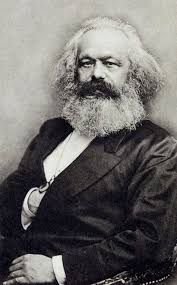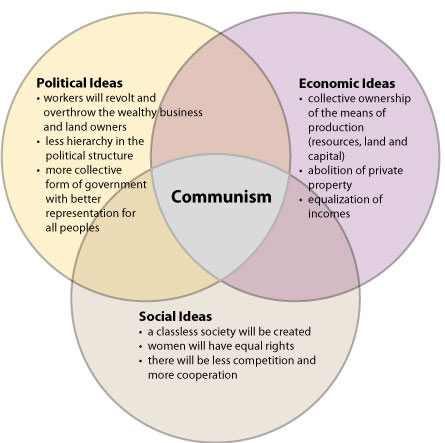Lesson One: Karl Marx and Communism
| Site: | MoodleHUB.ca 🍁 |
| Course: | Social 30-2 RVS |
| Book: | Lesson One: Karl Marx and Communism |
| Printed by: | Guest user |
| Date: | Monday, 27 October 2025, 8:12 AM |
Description
1. Introduction
The Rejection of Liberalism: Soviet Union
Issue Question: Is resistance to liberalism justified?
- Appreciate how citizens and citizenship are affected by the promotion of ideological principles
- Appreciate how citizens and groups may adhere to various ideologies
- Analyze ideological systems that rejected liberalism
- Examine how ideological conflict shaped international relations after World War II
- Examine perspectives on the imposition (forced acceptance) of liberalism
- Examine the extent to which modern liberalism is challenged by alternative ideas
- Evaluate the extent to which resistance to liberalism is justified
Duration: 1 blocks (80 mins + homework)
Karl Marx, along with other thinkers of the 19th century, experienced the turmoil of the Industrial Revolution in his native Germany. Industrialization brought about terrible living and working conditions. Men, women, and children worked long hours in unhealthy conditions for minimal pay. The utterly desperate conditions of the large numbers of working class poor were in stark contrast to the wealth of the few capitalists. It was a time characterized by inequality in which only the wealthy were really free. Karl Marx, a socialist thinker, argued that laissez-faire capitalism resulted only in slavery for the working classes. Marx rejected liberalist values and promoted wholly collectivist values. Marx developed the socialist ideology of communism. Until about 1990, communism existed in the former Soviet Union (now Russia) and in most Eastern European countries. Today, communism exists in China, Vietnam, North Korea, and Cuba.
Karl Marx (1817-1883)
|
|
|
|---|
3. Lesson
Please watch the following two videos, the first one reviews the ideology of collectivism
and the second one reviews the combined economic and political spectrums.
Now that you have done some review from unit 1, lets take a closer look at Karl Marx and why he rejected classical liberalism.
In unit 3 you learned how classical liberalism introduced rights, freedoms, and equality, both politically and economically during the 19th century (1800s). As you well know, not everything about classical liberal ideology was viewed as beneficial. Equally important, you learned that as liberalism developed and evolved, liberal ideology produced several negative conditions that did not benefit society, especially the workers. Though his experiences in the Industrial Revolution Karl Marx came to view capitalism as slavery for the working classes. Marx rejected liberalist values and promoted wholly collectivist values. Marx developed the socialist ideology of communism. Until about 1990, communism existed in the former Soviet Union (now Russia) and in most Eastern European countries. Today, communism exists in China, Vietnam, North Korea, and Cuba.
Marxism - Karl Marx and His Theory of Communism
In the Communist Manifesto, Marx called upon workers everywhere to get together and rid themselves of capitalists and capitalism:
"Workers of the world unite! You have nothing to lose but your chains!"
According to Marx, workers are individually enslaved, but together they are a force that could change the world. The workers would develop a new society based on equality and freedom. The first step towards that society would be violent revolution. Revolution would occur not because conditions were really bad and needed improving, but because it was inevitable. Nothing could stop it.
Marx believed that human history was an ongoing classconflict. That is, history was a struggle between the class of people who owned the means of production (the bourgeoisie - capitalists who owned the means of production) and the class of people that did not (the proletariat - the workers). According to Marx, this conflict would result in a revolution of the proletariat against the bourgeoisie, producing a new communist society.
If a new classless society based on cooperation were constructed, government would be unnecessary. Simple worker's organizations would ensure the communist goal: "...from each according to his ability, to each according to his needs." In other words, the common good would be taken care of collectively because each worker would provide for society according to their skills and then take back from society what he or she needed.
Would revolution create a classless society? No, Marx believed it would just be the first step. In the beginning, the proletariat would take over the government and control the means of production while changing private property into public property. This would be a period of socialism that would move eventually towards the true state of communism. At that point, government would cease to exist and society would be run by collective groups of workers.
Please watch the following video explain Capitalism and Socialism: |
|
On the spectrum, communism would be located as shown in the diagram below:

This video will provide you with the an understanding of the benefits of communism.
4. Assignment

Assignment One of One (6 marks)
Read the attached article titled "Marx's Law: A Rejection of Capitalism." After you have read the article, please complete the U4L1 Quiz.
This quiz is based on the reading Marx's Law. Please read and refer to the reading as you complete this OPEN BOOK quiz. You only have one attempt and 90 minutes to complete it so please do not attempt the quiz until you are able
to sit down and read the article, Marx's Law.
There is 6 multiple choice questions.
The password for the quiz = marx
5. Conclusion
Basic Ideas of Marx's Communism

